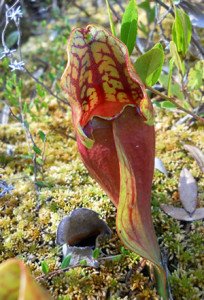Mapping rare plants and their habitats in Alberta’s Lower Athabasca region may help industry plan developments mindfully.
In Alberta’s northeastern Lower Athabasca region, famously known for its bitumen-rich oil sands, there are more than industrial giants digging in the dirt for treasure.
It’s also home to a treasure trove of extraordinary plant life, like the carnivorous pitcher plant that thrives in bogs and feeds on insects that drop unsuspectingly into its ‘cups’ of liquid when they lean too close to drink. Or varieties of orchid, nodding tiny sculptured blooms in their boreal forest habitats, and flowering plants like the cuckoo flower, that dwell along streams.
Hot on their trail is Dr. Scott Nielsen, a professor in the Department of Renewable Resources at the University of Alberta and a scientific collaborator with the ABMI. He’s spent the past two years leading an innovative project to develop protocols to find and map rare plant hotspots in the Lower Athabasca.
It’s an important task: with increasing industrial development in the oil sands, the Ecological Monitoring Committee for the Lower Athabasca (EMCLA), a consortium of oil sands companies, government ministries and agencies coordinated by the ABMI, was created to undertake this type of work. Nielsen’s rare plant project is one of three specialized ecological projects for the EMCLA in the rapidly-developing region. All are designed to inform land use and resource development decision-making.
One of the protocols Nielsen is developing is to take an adaptive sampling approach for locating rare plants. “Our approach is to develop a spatial model of the plant’s habitat, based on the type of environments that these species prefer,” explains Nielsen. “We then create maps divided into the locations where we think the species will be for future field sampling.”
While the project began with about 100 rare plant species for study, Nielsen narrowed the number down to a “couple of dozen” of the most rare species, like the pitcher plant, in the northeast. This way the project remains manageable and effective, and the adaptive sampling model can be more easily refined.
“I think of this project as prioritizing both species and places,” he says. Nielsen notes that plants considered rare in Alberta may proliferate elsewhere; others might be rare in northeast Alberta and not found elsewhere, so there’s plenty to weigh up in deciding which plants truly meet the project’s criteria.
Nielsen, who previously developed maps and models of grizzly bear habitats for the forestry and energy industries in planning developments, says rare plants appear to be most commonly found in three types of habitats. “A number of them are found in fens, which have flowing water and neutral to high pH levels, or bogs of standing water that is typically acidic,” he says. Thirdly, upland old growth forest stands are also home to rare plants. “Within these habitats we are also trying to find very specific environments. For example, we want to know what types of fens certain plants may occur in,” says Nielsen.
By building and refining maps of rare plant hotspots, the project is prioritizing places that are critical for rare plant species and which can inform land use planning efforts. For example, “if a site hasn’t been developed yet, the development could be shifted to another area that’s less sensitive,” says Nielsen.
It’s valuable information for restoration purposes too. “When industry is trying to restore parts of the landscape, we would be able to indicate which rare species and their habitats to focus on,” he explains.
The project’s second field season is winding down. Nielsen and his team have been experimenting with different methods of searching for rare plants that complement and extend the ABMI’s monitoring protocols. “In rare plant surveys there’s always a trade-off between expanding your search area, versus spending more time in a limited area,” he says. ABMI field crews have 20 minutes to identify as many species as they can on a quarter hectare plot. By contrast, the rare plant monitoring crews can spend as much time as they wish on the same size plot.
Success has been heartening. “I wasn’t expecting that we’d come across as many rare species as we have,” says Nielsen. He attributes this success to several factors, including locating field crews in places where rare species are predicted to be and allocating unlimited time to survey each plot.
Or perhaps some of the species, where were initially thought to be rare, actually aren’t.
To Nielsen, this underscores the importance of prioritizing both species and places. “Some species on our list that were thought of as rare, turn out not to be. As a result of this new information, we remove those species from the category of rarity,” he says. “Similarly, it’s just as important for us to be able to designate with confidence that a species is indeed rare, so that monitoring can be focused on habitats and species most threatened in the Lower Athabasca.”
“So we have our work cut out for us to ensure that when we’re working with industry consultants doing their environmental assessments, that our information and products becomes as useful as possible, rather than a report sitting on a shelf.”
———————————————————————————————
More Information on Monitoring
How does the ABMI monitor biodiversity?
The ABMI collects data on Alberta’s species and habitats at 1656 sites located systematically in a grid – every 20 km – across the province. At each site, data is collected from both land and water habitats. To understand trends in biodiversity, the ABMI crews revisit each site every five to seven years. Data are stored on the ABMI’s website at www.abmi.ca and are publicly available.
What is adaptive sampling?
Often in ecological surveys a random sampling approach is employed; in this case, researchers choose survey locations randomly to avoid the introduction of bias. In adaptive sampling, future survey locations are chosen based on information gathered in earlier surveys. In Scott Nielsen’s rare plants project, the researchers developed maps based on evidence of the preferred habitats or ecosites of various rare plant species. These maps direct initial survey efforts, but are constantly refined as new information comes in.
For more information:
- Please visit www.abmi.ca to learn about the Alberta Biodiversity Monitoring Institute’s activities and projects
- Please visit www.emcla.ca to learn more about the work of the Environmental Monitoring Committee of the Lower Athabasca
- Please visit www.ace-lab.org to learn more about Scott Nielsen’s research program
Top photo: Wild Orchind (Cypripideum acaule) (c) Amy Nixon




